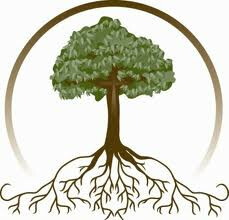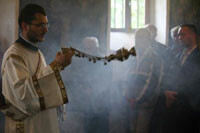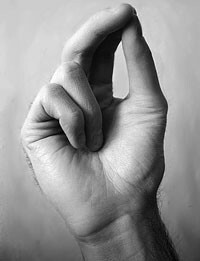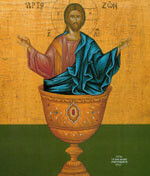We are Ancient and Liturgical
 The root of Christianity is Judaism, and the Jewish liturgical life did not come to a screeching halt with the resurrection of Jesus Christ; on the contrary, certain elements have continued to be preserved and practiced in the Orthodox Church from the time of Christ to this very day.
The root of Christianity is Judaism, and the Jewish liturgical life did not come to a screeching halt with the resurrection of Jesus Christ; on the contrary, certain elements have continued to be preserved and practiced in the Orthodox Church from the time of Christ to this very day.
Therefore, you will encounter lamp-stands, burning incense, iconography (inc. Cherubim of old), Priestly vestments, worship articles, and centuries old vocal chant; all of which were used in the Jewish liturgical worship services beginning with Moses and the Tabernacle as directed by God Himself. Here's a glimpse of the rich symbolism you will encounter at every service:
Incense symbolizes our prayers ascending to heaven as a sweet-smelling aroma, an acceptable sacrifice, well pleasing to God. (Philippians 4:18; Ephesians 5:2).


Levitical Incense
Orthodox Incense
 Prayers are offered in the Holy Spirit, and through Christ they come to the Father; hence, we worship the three Persons of the Holy Trinity all at once. (Romans 15:30; Phil 1:19)
Prayers are offered in the Holy Spirit, and through Christ they come to the Father; hence, we worship the three Persons of the Holy Trinity all at once. (Romans 15:30; Phil 1:19)
![]() Icons are venerated but not worshiped as wood, and they depict either the lives of the Saints, our Lord Jesus Christ Himself, or the many festivals or miraculous events that have occurred throughout history.
Icons are venerated but not worshiped as wood, and they depict either the lives of the Saints, our Lord Jesus Christ Himself, or the many festivals or miraculous events that have occurred throughout history.
 Candles represent the internal Grace of each Orthodox Christian, and are often offered with a personal prayer.
Candles represent the internal Grace of each Orthodox Christian, and are often offered with a personal prayer.
The sign of the cross is made with the right hand while venerating, praying, or prostrating; before eating, during times of fear or temptation, or whenever the protection and power of the seal (i.e. sign) is besought. The thumb, index, and middle finger are brought to a point which symbolizes the Trinity. The ring and pinkie finger are held together symbolizing the two natures of Christ (i.e. fully human, fully divine). Finally, the three fingers are placed on the forehead, moved down to the lower stomach, to the right shoulder, and then horizontally across to the left all the while praying "In the Name of the Father, Son, and Holy Spirit. Amen"


 Holy Communion is the actual body and blood of our Lord and Savior Jesus Christ, the God-Man. The Church has always understood the bread and wine to be mystically transformed into the actual body and blood of Christ. Jesus instituted it Himself at the Last Supper, and as with all Sacraments, there's a visible and invisible reality that exists. Please read the sacraments for more information.
Holy Communion is the actual body and blood of our Lord and Savior Jesus Christ, the God-Man. The Church has always understood the bread and wine to be mystically transformed into the actual body and blood of Christ. Jesus instituted it Himself at the Last Supper, and as with all Sacraments, there's a visible and invisible reality that exists. Please read the sacraments for more information.
 Full Prostration, also simply called prostration, is an act of distributing one's weight on the knees, feet, and hands, touching the forehead to the floor and staying in that position for as long as is desired, and then standing up. One usually makes the Sign of the Cross before or after the movement.
Full Prostration, also simply called prostration, is an act of distributing one's weight on the knees, feet, and hands, touching the forehead to the floor and staying in that position for as long as is desired, and then standing up. One usually makes the Sign of the Cross before or after the movement.
Half Prostration, also called metanoia, is performed by bending from the waist and touching the ground with the right hand open and facing outward. One usually makes the Sign of the Cross immediately before or after the movement. It is often used as a substitute for the full prostration.
 A Priest leads and spiritually protects the faithful flock of Christ. Liturgically, a priest symbolizes our eternal High Priest, Jesus Christ, who transformed the Levitical priesthood through his death and resurrection. Ever since God established the Levitical priesthood through Moses in the desert, up until today, a priest has always led the faithful in the liturgical worship of the One, True, and Holy God.
A Priest leads and spiritually protects the faithful flock of Christ. Liturgically, a priest symbolizes our eternal High Priest, Jesus Christ, who transformed the Levitical priesthood through his death and resurrection. Ever since God established the Levitical priesthood through Moses in the desert, up until today, a priest has always led the faithful in the liturgical worship of the One, True, and Holy God.
©2024 Sts. Kosmas & Damianos Greek Orthodox Church / Rochester's Orthodox Church
Powered by Ekklesia 360